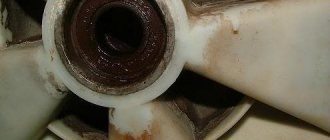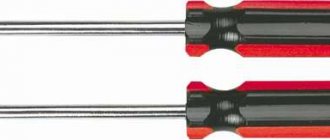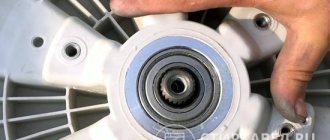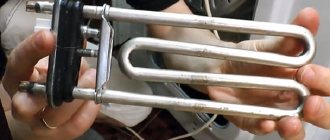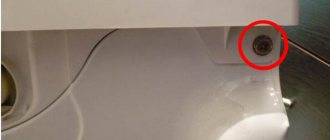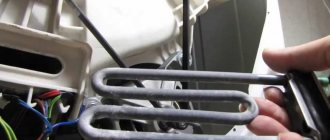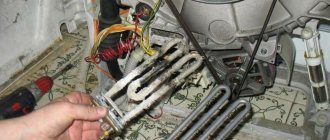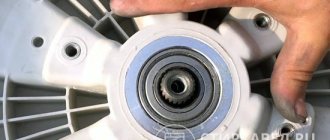How the malfunction manifests itself
If you notice that the water does not heat up during washing, you should not immediately disassemble the machine. You need to make sure that the spiral is not working, and then determine the reasons for this phenomenon.
First, you should understand that after rinsing is completed, the laundry should not be warm. To save electrical energy, cold water is used, so it is impossible to determine from the temperature of wet laundry whether the heating element is working or not.
The check is performed in a different way: 20 minutes after the start of washing, the palm is placed on the glass of the loading hatch. If it is warm, the heating element is working. A cold surface indicates that the water is not heating up. In this case, you will have to change the heating element.
Many owners of household appliances are interested in what causes the heater to fail. Failure occurs in the following cases:
- Failure of the heating element due to scale. The reason for its formation is hard water, which contains high concentrations of magnesium and potassium salts. When the heating element is turned on, the water heats up and substances settle on the surface of the spiral. After some time, the coating becomes harder, turns to stone, and the entire surface of the part becomes covered with a crust. This leads to a disruption in heat exchange, and the heating element burns out.
- The coil may burn out due to a voltage drop.
When the heater fails, it is replaced, but you need to start with preparatory measures.
How to change the heating element in an LG washing machine
Failure of the heating element - heating element - is a fairly common malfunction in washing machines. Tap water often contains a large amount of mineral salts; as a result, when the water is constantly heated, the element becomes covered with scale, which significantly reduces its service life. As a result, the machine stops heating the water.
If the heating element of your LG washing machine is out of order, we advise you to contact the LG Brand Service by leaving a request by phone 8-499-677-76-76 (for calls from Moscow and the Moscow region) or by phone 8-800-200-76- 76 (for calls within Russia). LG Branded Service specialists will quickly and efficiently carry out repairs of any complexity. But if you feel like a jack of all trades and want to take on the troubleshooting yourself, we have prepared for you step-by-step instructions on how to replace the heating element in an LG washing machine.
Replacing heating elements in an LG washing machine: step-by-step instructions
You can replace a faulty heating element in an LG washing machine without resorting to the services of a technician. The vast majority of LG models are direct drive, which means there is no drive belt that could get in the way when replacing the heating element.
How to remove the heating element in an LG washing machine
- Before you start replacing the heating element, make sure that your washing machine is unplugged. Turn off the water and disconnect the inlet and drain hoses.
- In LG washing machines, the heating element is located under the tank, which makes it easy to change the heating element.
- Remove the back panel of the washing machine (usually it is attached with bolts or screws).
- You will see the outer part of the heating element with external contacts at the bottom of the tank wall.
- Remove the wires from the heating element. Before doing this, you can take a photo of their location on your smartphone so that when installing the element in place, you won’t make a mistake.
- Loosen the nut located in the center of the heating element so that it rests on the end of the thread. Press it in along with the pin.
- Now you can get the heating element. This will be easier to do if you carefully pry the part off with a screwdriver or knife. Remember that the surface of the element, contacts and seat are very vulnerable to mechanical damage, so you need to act slowly and carefully.
How to install a heating element in an LG washing machine
- Before you start replacing the element, prepare the seat by clearing it of scale and dirt.
- Lubricate the seat, seal and the element itself with any lubricant for technical parts.
- Carefully place the new heating element into place.
- Screw on the nut and tighten it with a wrench.
- Connect the terminals and wires.
- Assemble the body of the machine, then run the machine without laundry on high temperature mode. You can check whether the new heating element in your LG washing machine is working by touching the glass of the loading hatch after 15 minutes of washing: it should be warm.
In order for a new heating element to last a long time, you need to choose the right part. Carefully study the SMA data sheet and determine the power of the element. For LG washing machines, the figure is usually 1900-1950 Watt, but for some models the power can be 2 kW.
If for some reason you cannot look at the data in the data sheet, then you can find out the information on the heating element itself: markings may be applied to it. It is these values that will help you not make a mistake when purchasing and choose the part that will suit your LG washing machine.
You can buy heating elements at an LG service center, in a specialized spare parts store or in an online store. Experts recommend not purchasing parts second-hand, especially second-hand ones.
Where is the heating element located?
Before you begin work on replacing the heating element, the water is drained from the machine. It is de-energized and only then disconnected from the water supply and sewerage system.
The equipment is deployed so that access to the rear of the machine is ensured, after which the panel is carefully removed.
First you need to determine the location of the TEN. There is no drive belt in LG household appliances, so it will not interfere with the removal of the spiral, but it is better to clarify what structure the machine has before starting work. This information is given in the instructions.
When the back wall is removed, a view of the internal parts will open. The spiral is easy to find; its contacts will be clearly visible. It is located near the barrel. There are many wires connected to it, everything is carefully disconnected.
It is necessary to remember the location of the wires; it is better to draw a diagram.
This stage is important. If the wires are mixed up when connecting, the heater will fail, and the machine may also break down.
We remove the old one
To change the heating element, the old one must be removed. This is done as follows:
- The machine body must be disassembled;
- The drive belt (if any) should be removed so that it does not interfere with operation;
- The wires going to the heater terminals must be disconnected (remembering their location);
- Disconnect the positive wire from the temperature sensor terminal;
- Loosen the central nut fastening the heating element (without unscrewing it completely);
- Push the pin on which the nut sits inside the housing (but carefully so that the heating element does not fall into the tank;
- Using several flathead screwdrivers, remove the heating element, being careful not to damage the washing tub.
Before carrying out the above steps, you should determine where the heater is located. After this, the back or front walls of the machine covering it are removed. In different models, the covers can be attached in different ways, namely, with a different number of bolts.
If the car has a drive belt, then it can be removed using a screwdriver, which should be used to carefully pry it up and then it can be easily pulled out. The main thing is not to scratch the belt, otherwise it will definitely break later.
As for the heating element terminals, there are usually four of them. This is grounding, a wire from the positive terminal of the temperature sensor and two power cables. The first two may not exist, depending on the car model.
Important: be sure to disconnect the washing machine from the electrical power supply for the period of repair work!
When removing the heating element, a situation may arise where it will not be easy to get it out. This can happen due to deformation of the rubber o-ring, which hardens over time and sticks to the edges of the heater. In this case, you should carefully pry it off with a flat screwdriver and, helping with your hand, remove the heating element. If the seal is unsuitable, then it should be changed.
What will be needed for replacement?
So, having purchased the necessary part for repairing washing equipment, prepare the tools for its installation. You will need:
- Two screwdrivers - flat and Phillips;
- Spray lubricant to loosen boiled joints (eg WD-40);
- Multimeter;
- Keys and socket heads of the required sizes to remove the back cover (in most cases, a “figure eight” will do).
Prevention of breakdowns
Maintenance of the heating element is carried out in such a way that scale does not form on it. Most often, the water entering the tap is too hard; you need to think about how to fix this and soften it. You can install special filters that will make the liquid normal for washing. If the water hardness is high, then it is necessary to avoid washing above 60 degrees and add a special powder.
If scale has already formed, you can clean the heating element with citric acid.
To do this, you need to pour it into the powder compartment and turn on the washing mode at 60 degrees without clothes. You can also do it at 90, if suddenly it seems that there is a large amount of scale. After this, you will need to clean the drum and heating element.
Such methods can prevent scale if the procedure is performed at least once every six months. To prevent its formation, you need to wash it in a mode that is no more than 40 degrees. In order to prevent other damage, you need to take a break between washes for about two hours.
This is necessary so that the LG SMA rests and does not overload itself. The formation of fungus must also be avoided. If even a small mold is suddenly noticed, you need to immediately disinfect it. It is important to remember that you only need to use high-quality powder for washing. After all, cheap household chemicals lead to the accumulation of salts on parts. If all preventive measures are followed, the washing machine will last a long time.
Where to look for the heating element?
LG's home assistant hides the heating element in a standard place for automatic washing machines - right at the bottom of the tank. Finding an electric heater is easy: you just need to turn off the machine from the power supply, turn off the water supply, turn the body 180 degrees and remove the back panel. Pay attention to the bottom of the drum - it is under it that there is a metal part connected to many different wires. You will never confuse it with the engine or other components, because the heating element is always located in the tank, surrounded by wiring.
But while searching for, dismantling and installing a new water heater is not difficult, diagnosing and understanding the causes of the breakdown can be much more difficult. The heater can become unusable due to a number of problems, which is why it is so important to accurately determine the cause of the problem in order to eliminate it and prevent the breakdown of the new heating element. Most often, a part fails for fairly mundane reasons.
- Sudden power surges.
- Incorrect operation of the heater temperature sensor.
- Overheating of the part due to a large layer of scale.
Scale caused by too hard or dirty water can be avoided by using water softeners such as Calgon.
- Banal carelessness of the user during operation.
- Moisture on the contacts of the part.
- Manufacturing defects.
Most often, replacing a damaged part can eliminate the malfunction and return the device to normal operation. But it is much worse if the reason is hidden in the control board, the replacement of which costs users much more. If the electronic control module is damaged, for example, the contacts have come loose and the tracks are damaged, then it will have to be repaired or replaced. And it is not recommended to carry out this procedure yourself, since it is too complicated for people without professional technical education. In this case, it is better to call a service center technician to your home.
Let's get to the details
Unlike some third-party washing brands, the location of the heating element in the LG machine is very convenient for the repairman - the desired spiral is located at the back. There is no need to disassemble half the body, as in Samsung machines; just remove the back wall and take a closer look. But there is no need to rush, since you cannot do without preparation for the process.
When disassembling the washing machine, you must follow safety precautions.
First of all, disconnect the machine from the electricity. For safety reasons, it is recommended to repeatedly check that the housing is de-energized, otherwise repairs cannot be started. The second step is to turn off the water, disconnect the inlet and drain hoses, and secure all the wires and tubes in the provided grooves on the body - so that long elements do not interfere with the dismantling of the heating element.
The next step will be to ensure free access to the machine. We move the free-standing machine away from the wall, and move the built-in models to the center of the room. Do not forget that the unit is heavy, and it is better to enlist the support of a couple of extra hands.
The preparation ends by spreading out old rags and removing the back panel. That's all. True, not everyone can immediately spot the heating element among the spare parts of an LG washing machine - the part is “hidden” in the depths of the case. Further instructions will help with the search.
Description and principle of operation of the heating element
The heating element is an electric heater responsible for heating cold water supplied from the central water supply system to the washing machine.
Structurally, it consists of a W- or V-shaped tubular part, inside of which there is a conductor element with a high level of resistance that can withstand heating to record high operating temperatures.
A multimeter will help you carry out a correct check of the heating element. Using this measuring device, you can “ring” (test) the heating element at home and determine whether it is working or not.
The heating coil is surrounded by a special dielectric insulator with a high thermal conductivity. It correctly absorbs the heat emanating from the heating element and transfers it to the steel outer shell.
The working spiral itself is soldered with its outgoing ends to the contacts, which receive power during operation. Nearby there is a thermal unit that measures the level of water heating in the washing tank.
When activated through the control unit of any of the processing modes, a command signal is sent to the heating element.
The element begins to warm up intensively and, releasing the generated heat, brings the temperature of the water in the washing drum to the required temperature specified by the user.
Progressive models have a special hole in their design for a temperature sensor (in the figure the arrow points to it). It vigilantly monitors the level of water heating in the drum and promptly turns off the working element, allowing you to rationally and economically consume electrical energy
As soon as the water reaches the required temperature, the sensor records this and transfers the data to the control unit. The system reacts to the information received and automatically turns off the device, stopping water heating.
